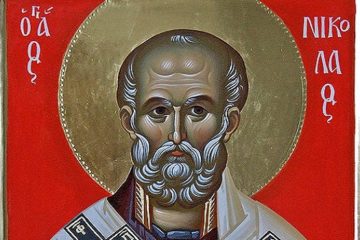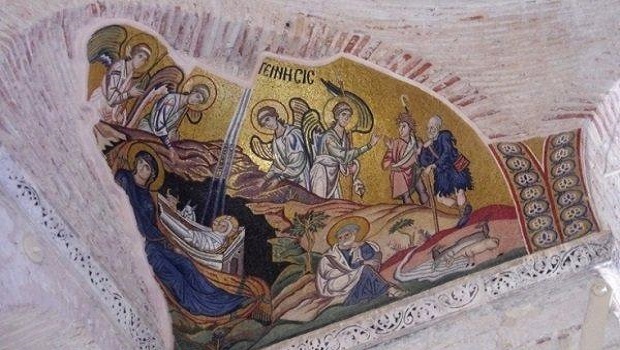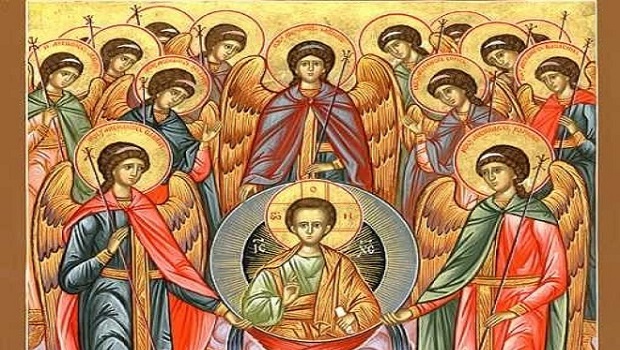Archimandrite Georgios Kapsanis, Abbot of the Holy Monastery of Gregoriou †
Only the heart of a person who is continuously being cleansed by repentance from egotism, selfishness and the passions can really love God and other people. Egotism and love are irreconcilable. It’s often the case that egotism believes it’s loving, but this ‘love’ is merely a patina of love that conceals selfishness and self-interest.
Monastics in repentance burn with Divine love. God’s love holds their hearts together, so that they don’t live for themselves alone, but for God. The soul/bride continuously seeks its bridegroom with pain and desire and finds no rest until its united with him. It’s not content to serve God as a servant (out of fear), nor as a hireling (with Paradise as a reward). It wants to love Him as a son, that is with pure love. ‘I never fear God, because I love Him’, says Anthony the Great. The more monastics repent, the more the desire for the love of God increases within them , and the more they love God, the more profoundly they repent.
The tears of repentance ignite the fire of love. Desire for the Lord is nourished by prayer, especially the unceasing prayer of the heart, the continuous invocation of the most sweet name of Jesus through the prayer ‘Lord Jesus Christ, have mercy on me, sinner that I am’. The prayer cleanses them and guarantees union with Christ.
In the Church’s worship, monastics also surrender themselves to God and God surrenders Himself to them. Monastics spend many hours a day in church worshipping our beloved Lord. Their participation in worship isn’t an ‘obligation’, but a need of the soul that thirsts for God. On the Athonite monasteries, the Divine Liturgy is celebrated every day, because there’s nothing better for them to do than to be in communion with their Redeemer, the Mother of the Redeemer and the friends of the Redeemer. And so the service is a feast and a joy, an opening of the soul and a foretaste of Paradise. In other words the monks live in an Apostolic manner: ‘And all who believed were together in one place and had all things in common. And, day by day, they bore up with one mind in the temple, and breaking bread in their homes, they received their food with gladness and simplicity of heart, praising God…’ (Acts 2, 44-7).
Even after the end of the service, monks and nuns live in worship. The whole of their lives in the monastery, the obedience they’re appointed to, the refectory, prayer, silence and rest, relations with the other members of the community and the hospitality towards strangers are tasks all offered to the Holy Trinity. The architecture of the monasteries reveals this reality.
Everything starts from and returns to the Katholiko [Main Church] and its Holy Altar. The corridors, the cells and everything else have the main church as their reference point. The whole of life is offered to God and becomes worship of God.
Even the material elements that are used in worship testify to the transfiguration of the whole of life and of creation through the grace of God. The bread and wine of the Divine Liturgy, the blessed oil, the incense, the talanda [wooden sounding boards] and the bells that mark the appointed hours, the candles and the icon-lamps, which are lit and extinguished at particular points in the service, the movements of the canonarch [roughly ‘precentor’] and the ‘vergers’ and so many other movements and actions, envisaged by the centuries-old monastics rules are not dry forms nor psychological motives for affecting emotions, but points, echoes and manifestations of the new creation. All those who visit the Holy Mountain see for themselves that worship isn’t static, but has a dynamic character. It’s motion towards God: the soul ascends to God and takes up with it the whole of creation.
At an Athonite vigil, the faithful enjoy the unique experience of the joy which comes into the world through Christ’s redemptive work and they taste the sublime quality of the life that He offers the world within the Church.
The priority given by monasticism to the worship of God reminds the Church and the world that, unless the Divine Liturgy and worship once again become the centre of our lives, our world has no chance of becoming united and transformed, of overcoming the rupture, the imbalance, the vacuum and death, despite the best efforts of humanistic systems and programmes for its improvement. Monasticism also reminds us that the Divine Liturgy and worship aren’t merely ‘something’ in our lives, but the ‘centre’, the source of the renewal and sanctification of all the facets of our lives.
(to be continued)
Read the first part here
Source: pemptousia.com
ABOUT THE ORTHODOX CHRISTIAN NETWORK
Orthodox Christian Network (OCN) is a 501(c)3 and an official agency of the Assembly of Canonical Bishops of the United States of America . It is a recognized leader in the Orthodox Media field and has sustained consistent growth over twenty-two years. We have worked to create a community for both believers and non believers alike by sharing the timeless faith of Orthodoxy with the contemporary world through modern media. We are on a mission to inspire Orthodox Christians Worldwide. Click to signup to receive weekly newsletter.
Join us in our Media Ministry Missions! Help us bring the Orthodox Faith to the fingertips of Orthodox Christians worldwide! Your gift today will helps us produce and provide unlimited access to Orthodox faith-inspiring programming, services and community. Don’t wait. Share the Love of Orthodoxy Today!
OCN has partnered with Pemptousia. A Contemporary post-modern man does not understand what man is. Through its presence in the internet world, Pemptousia, with its spirit of respect for beauty that characterizes it, wishes to contribute to the presentation of a better meaning of life for man, to the search for the ontological dimension of man, and to the awareness of the unfathomable mystery of man who is always in Christ in the process of becoming, of man who is in the image of divine beauty. And the beauty of man springs from the beauty of the Triune God. In the end, “beauty will save the world”.




0 Comments